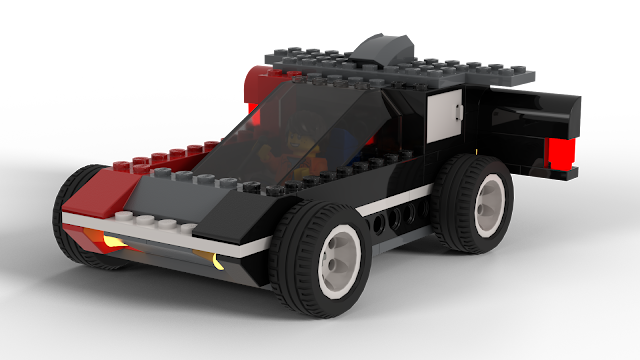Do you love speed? Do you like to drive undisturbed? Do you enjoy Turb(ine)o power? If your answer to all three questions was yes, then the Turbo L is the car for you.


This was the first road car designed by L when he was but a child. L's previous experience consisted of designing spaceships and robots but his first attempt at a road car does not disappoint.
The gas turbine is used to drive the wheels and for propulsion at high speeds. The cockpit is challenging to access but allowed two occupants originally: a driver and a passenger. There is a small drawer on each side of the car to store small items, just above the rear wheels. Due to the different windscreen, the rear axle was moved one stud rearwards to help balance the vehicle.
The most defining aspect of the Turbo L is the massive turbine mounted on the back of the car. The doors remain closed at low speed (there is a gap to allow for some air flow) but open wide when it is time to boost! The fuel tank is located below the cockpit to help balance the car and avoid it being to rear-heavy.
In terms of standard road equipment it has lights in the front and in the rear as well as indicators in the back. It is equipped with naked wheels for that F1 styling and that's about it - simple yet fast. The verdict? A car you want to own for its unique style, sitting in the centre of the car, this is not a GT, this is an experience.
How does it compare to the Tigre, Ramos' first Sportscar offer?
As a Roadster, the Tigre is fully equipped to sit two people comfortably, whereas the Turbo L is meant to be fast in a straight line. Let's compare the numbers:
The Turbo L is lighter than the Tigre at 151.1 g vs 166.7 g, about 10% lighter, the both have roughly the same external dimensions except for the length as the Turbo L is shorter by 3 studs. Where they differ quite substantially is in complexity and price. At 229 bricks (90 different ones) the Tigre is significantly more complex than the 91 bricks (60) of the Turbo L and this is reflected in the price: $51.91 vs $38.30 (taking into account the correct windscreen for the Turbo L from the Mars set).
These prices are significantly reduced with alternative brick choices, which can reduce the price of the Tigre (Tigre mk I revamp to be released soon) to a very competitive $35.58.
Speaking to the designer I did inquire about the width of the car. It is 12 studs wide, at a time when Lego city cars were around 4-6 studs and other Ramos cars measure around 10 studs due to the technic wheels. At the time he didn't seem very concerned "They can move out of the way when they see this car in their rearview mirror". I didn't inquire further but it is something I have addressed in a revamp of this vehicle, which could have 10 studs width after some minor modifications:
Due to colour availability, blue and red were used here. This would reduce the overall cost of the package to $33.74. The revamp is not available yet but will be available soon.
All in all the Turbo L is the raw sporting experience whereas the Tigre is a car to take for a ride on the weekends.
Link to this model in ReBrickable: https://rebrickable.com/users/Ramos_cars/mocs/
Specifications:
no doors, hidden turbine in the back
2 occupants with the correct windscreen
Size: 17 x 12 x 8 studs (0.8 studs ground clearance)
Mass: 151.1 g
Distance between axles: 10 studs.
Volume of boot: 9.83 cm3
Parts: 91 // Lots: 60
Price (May 2021): $38.30
In this blog I plan to add some in-depth detailed information about all the cars I built in the period between 2005-2006. The next post will be about Blue, my brother L's second vehicle (yes it's also meant for racing)









Comments
Post a Comment